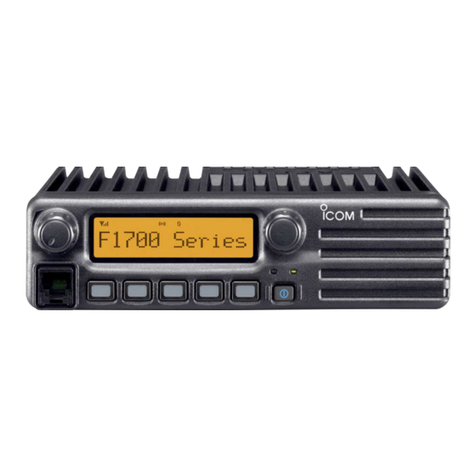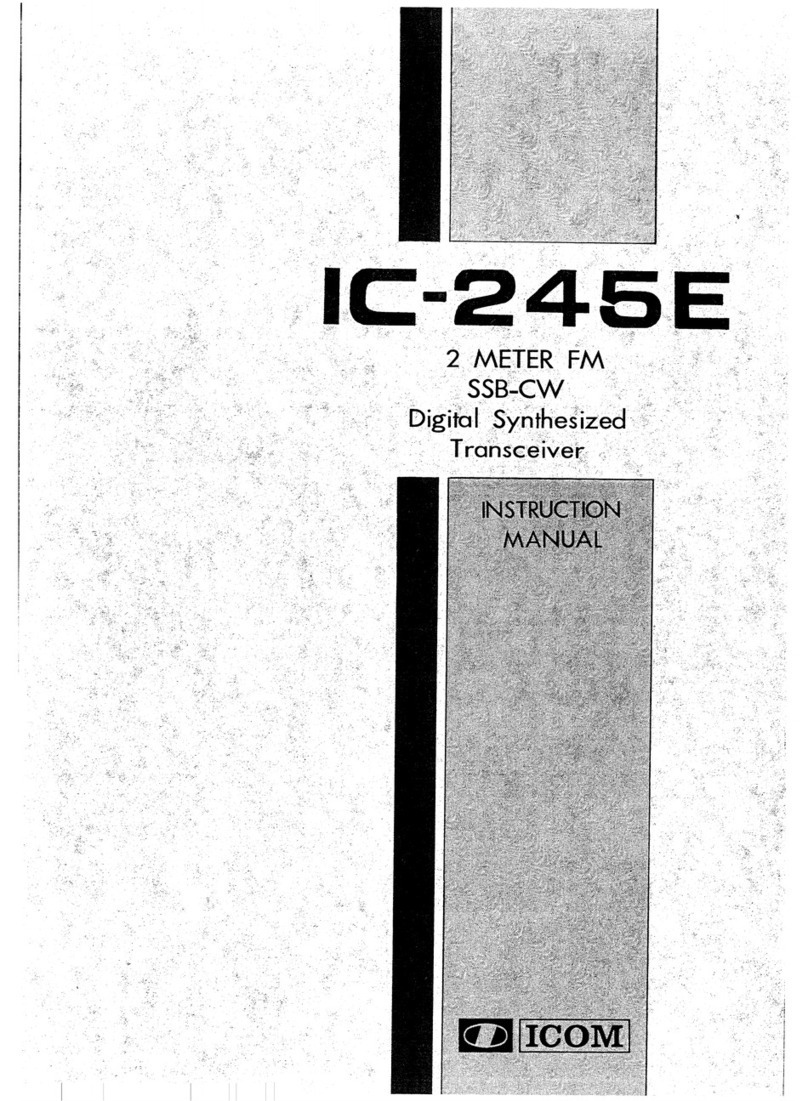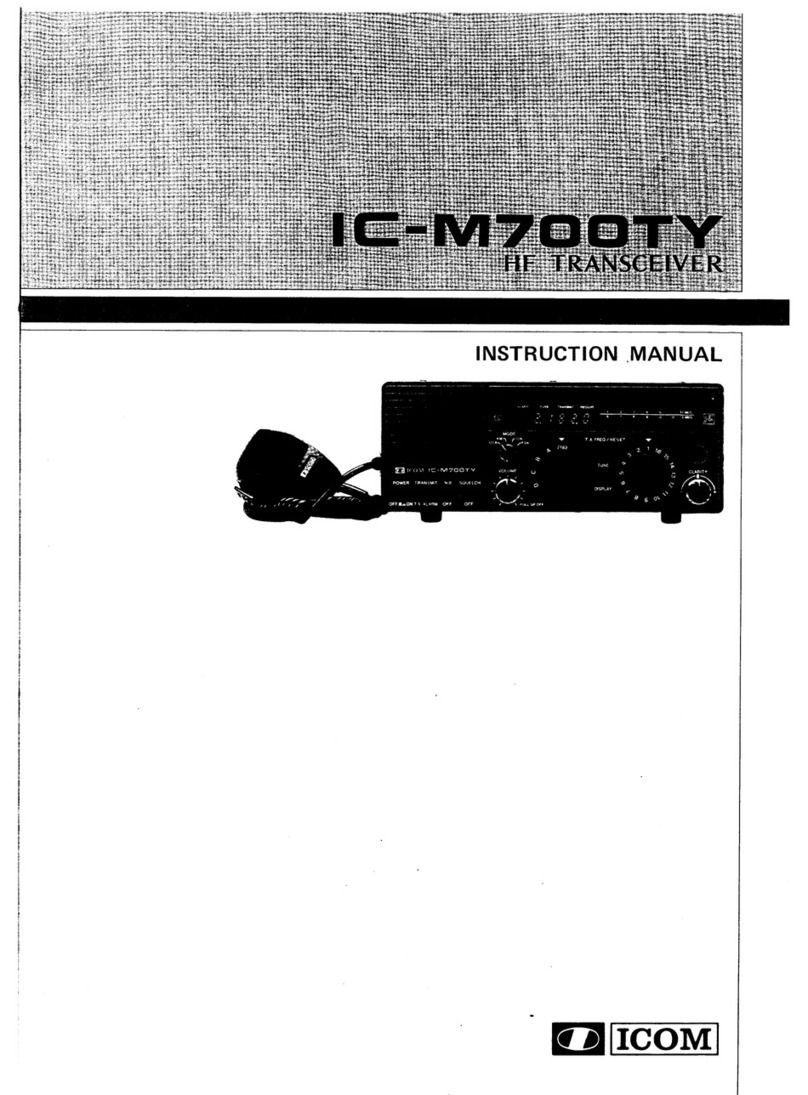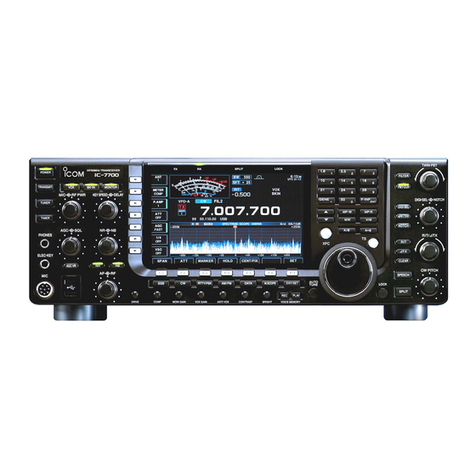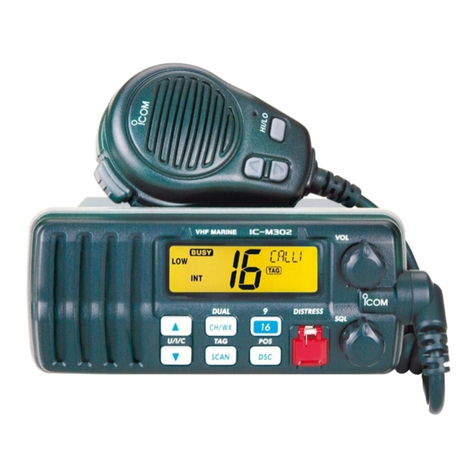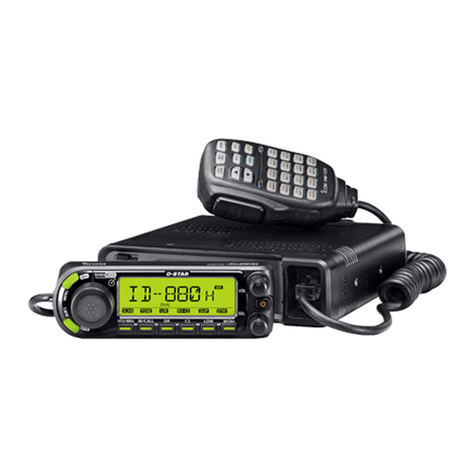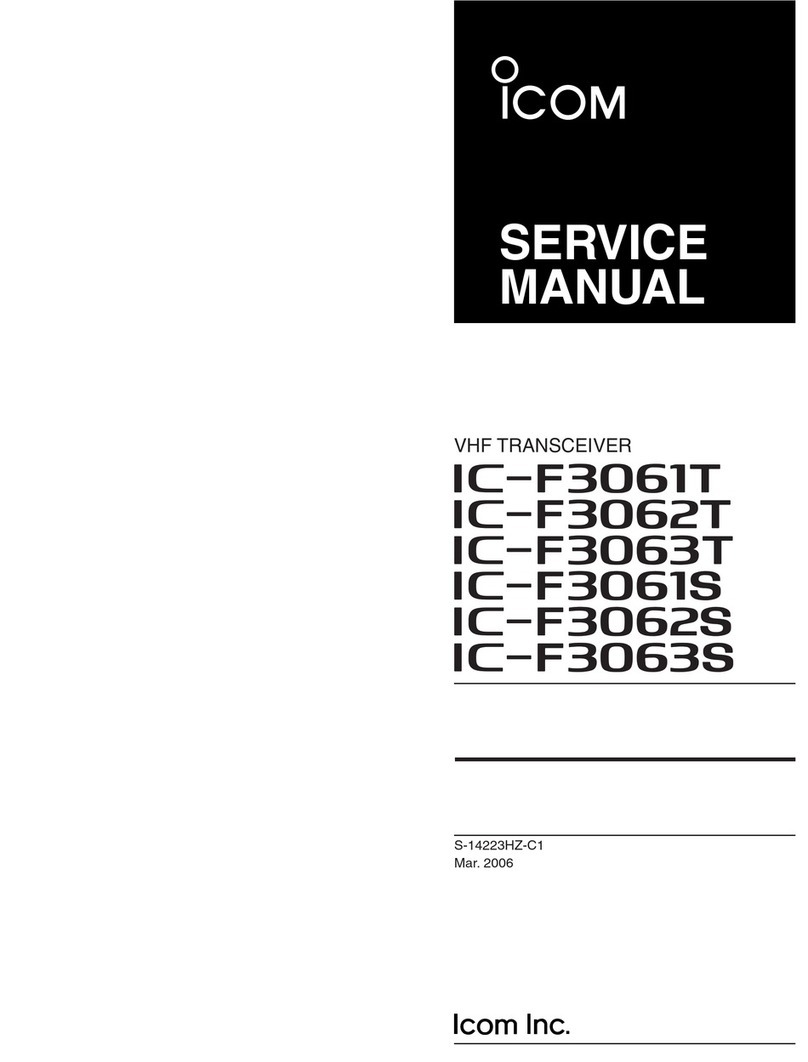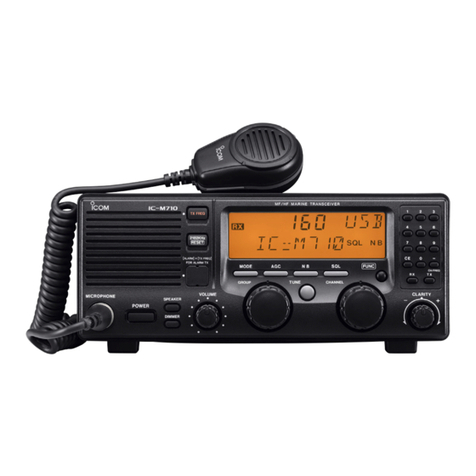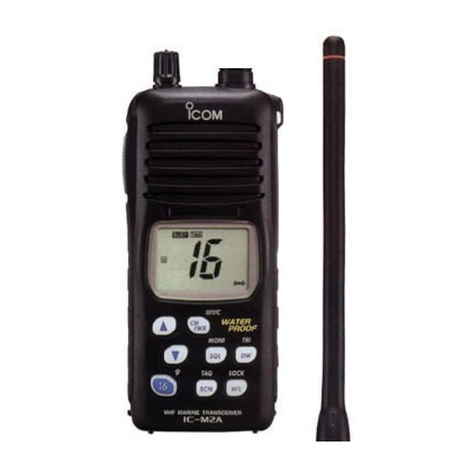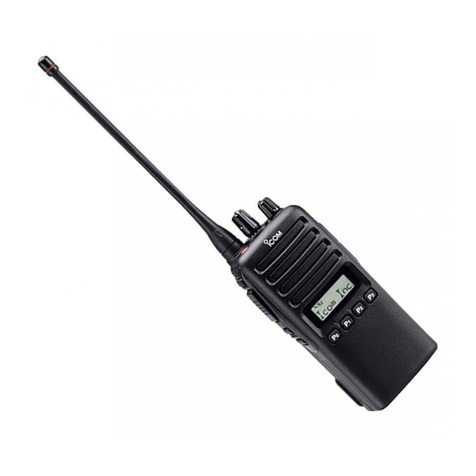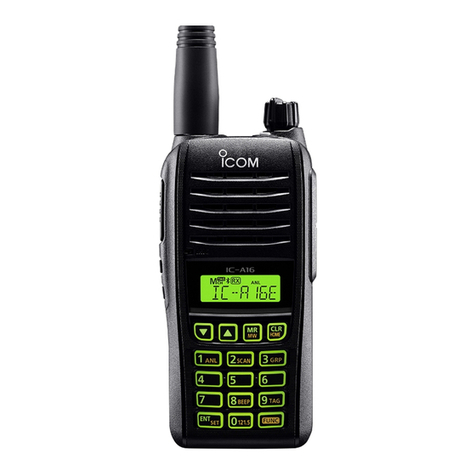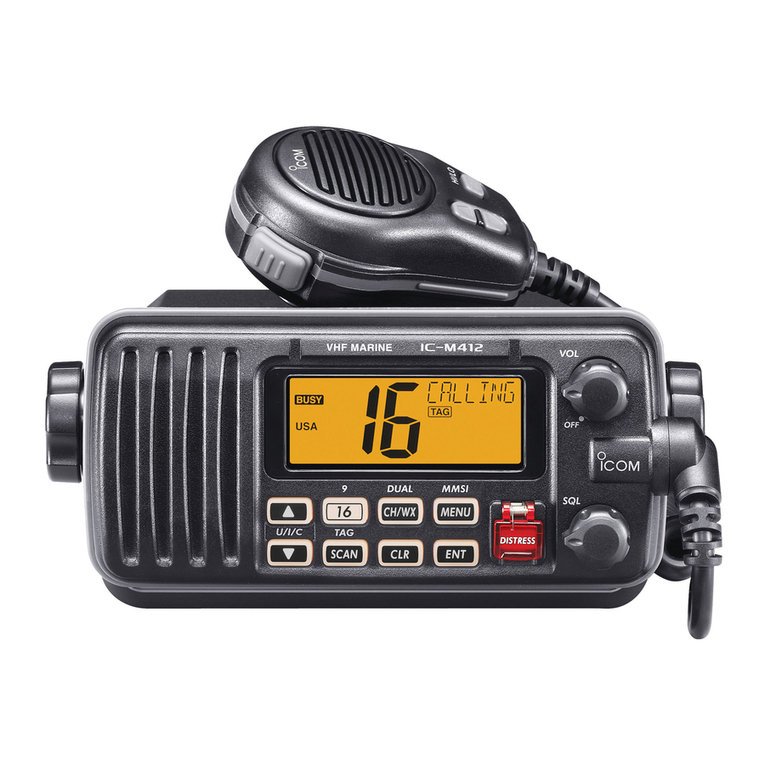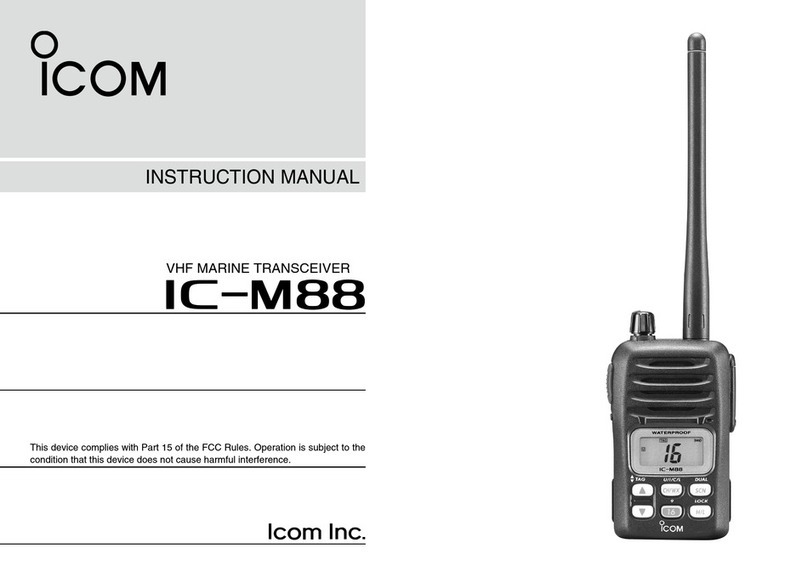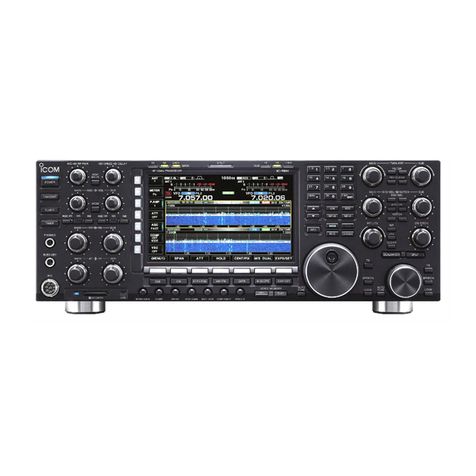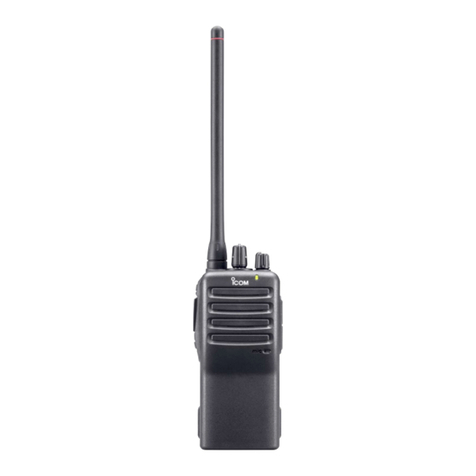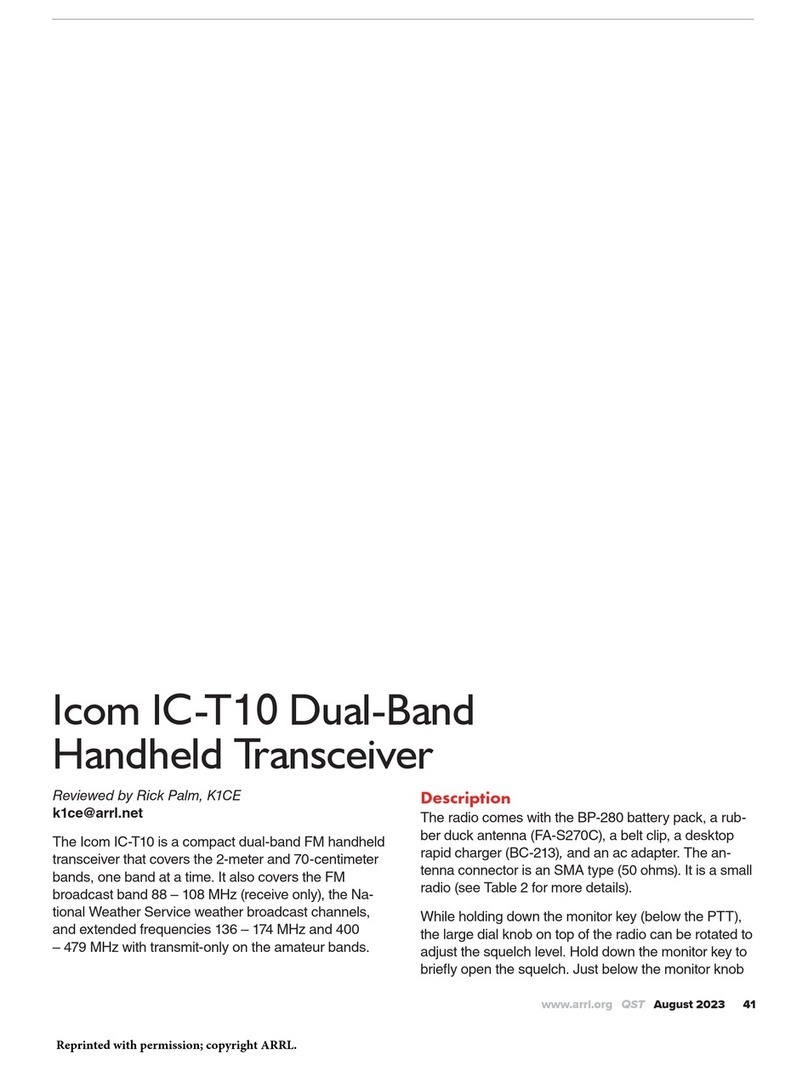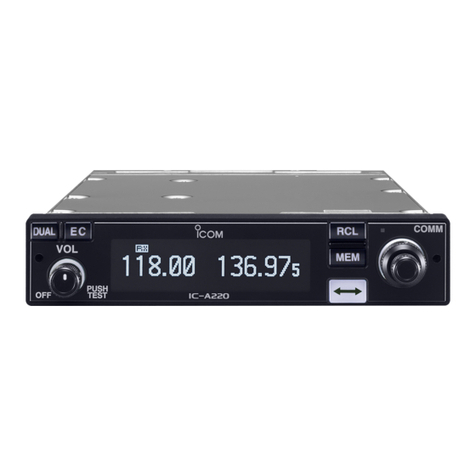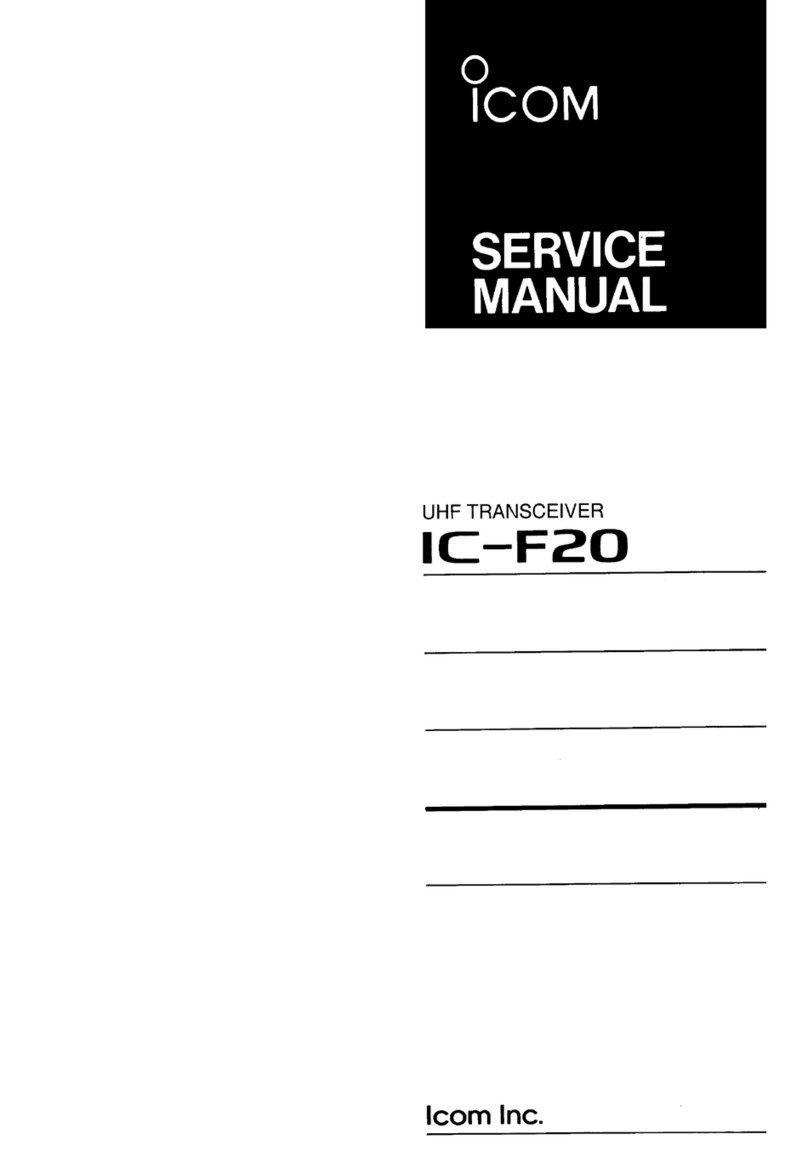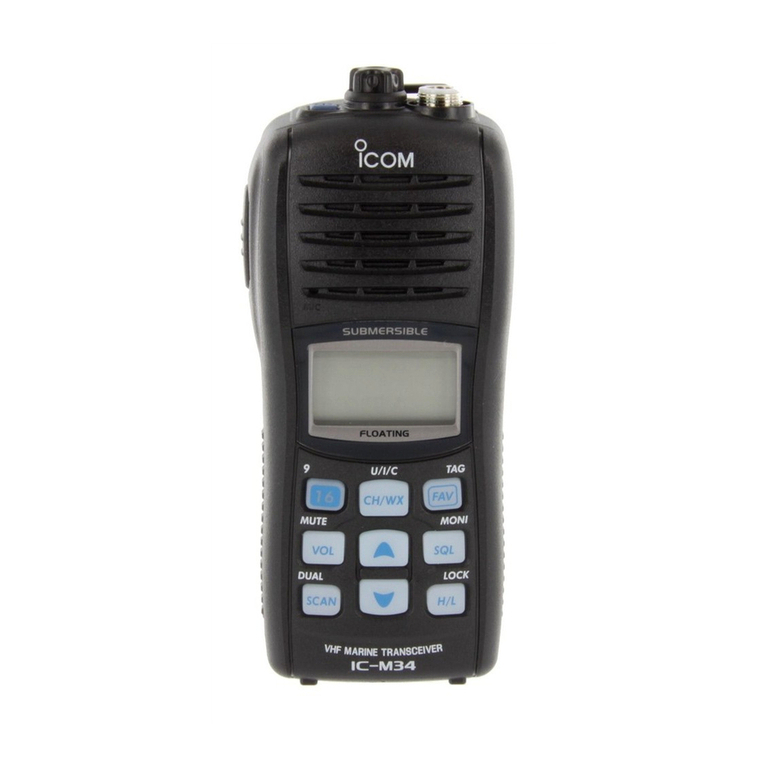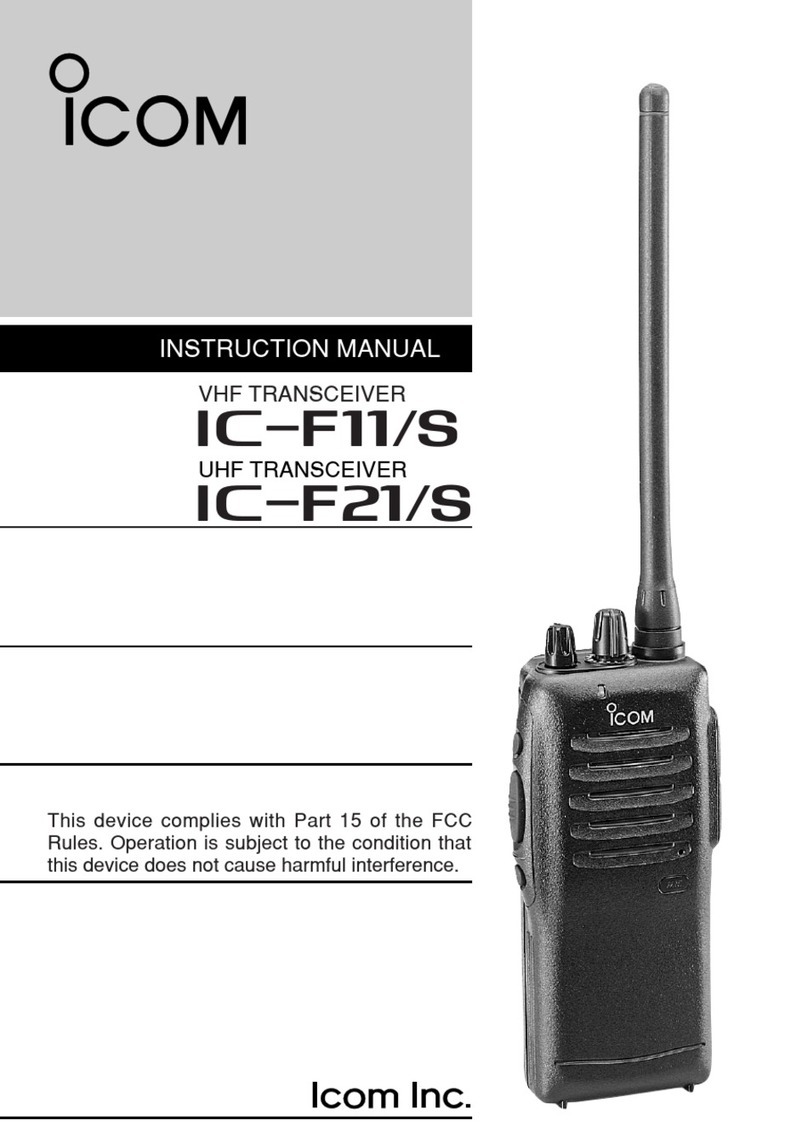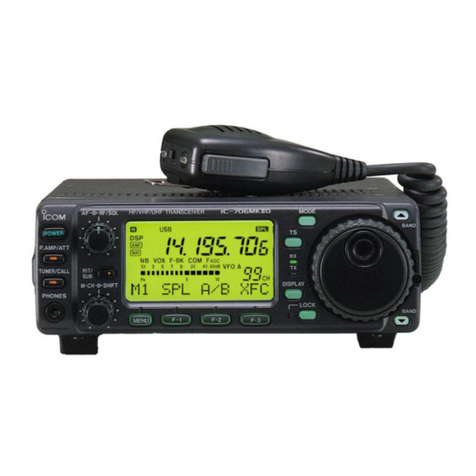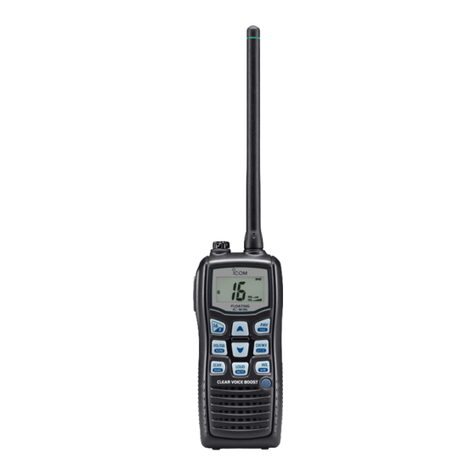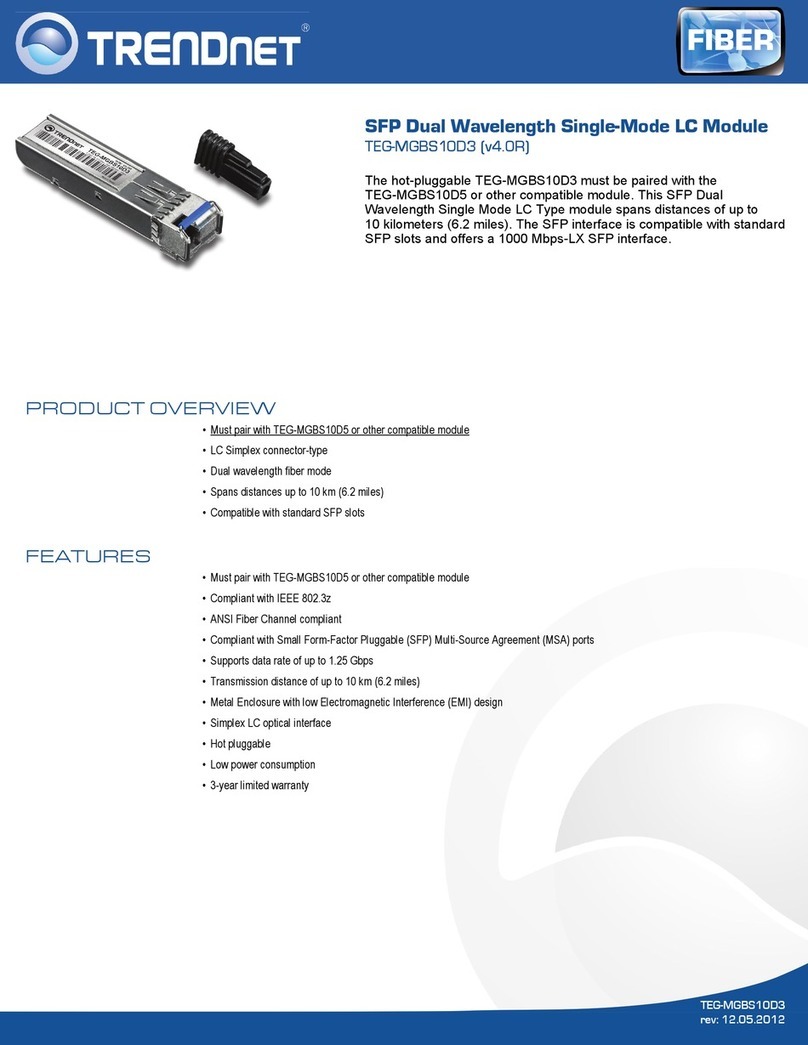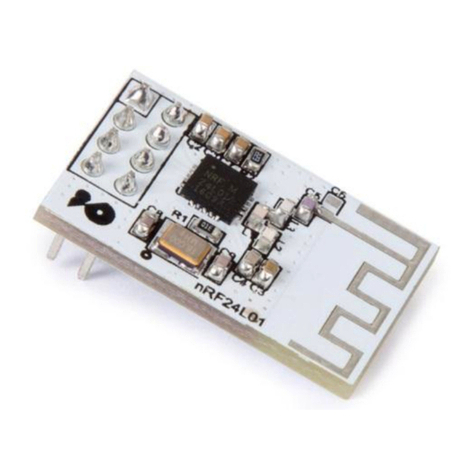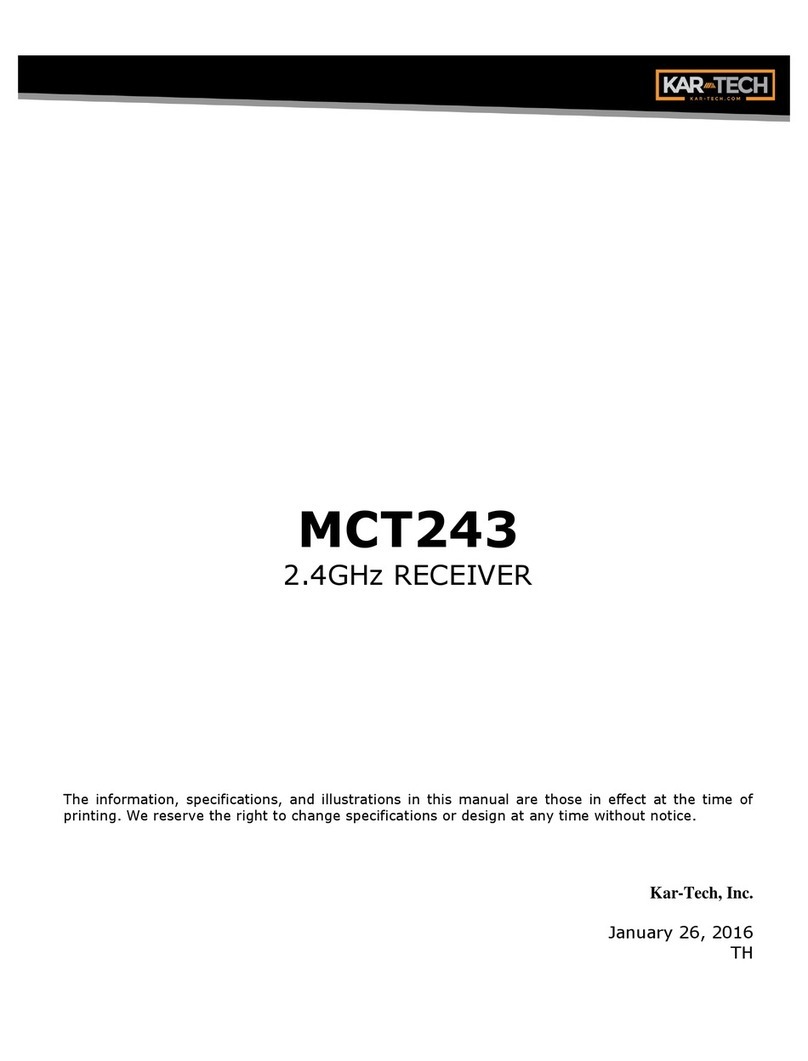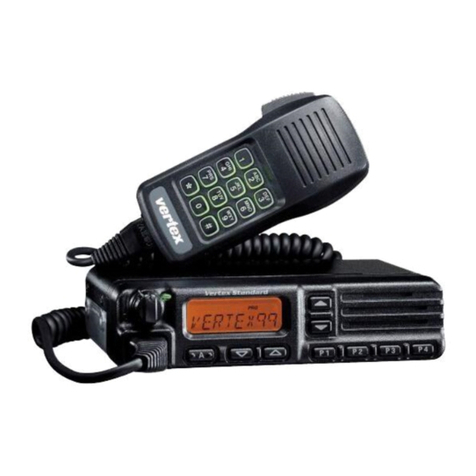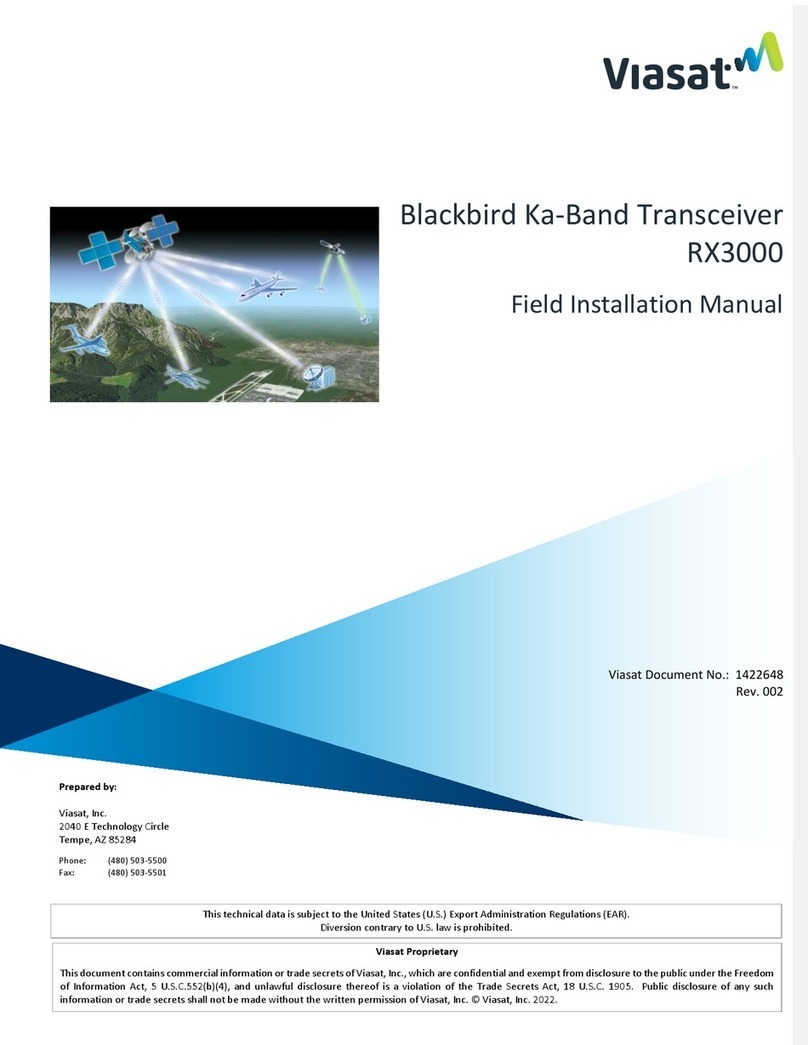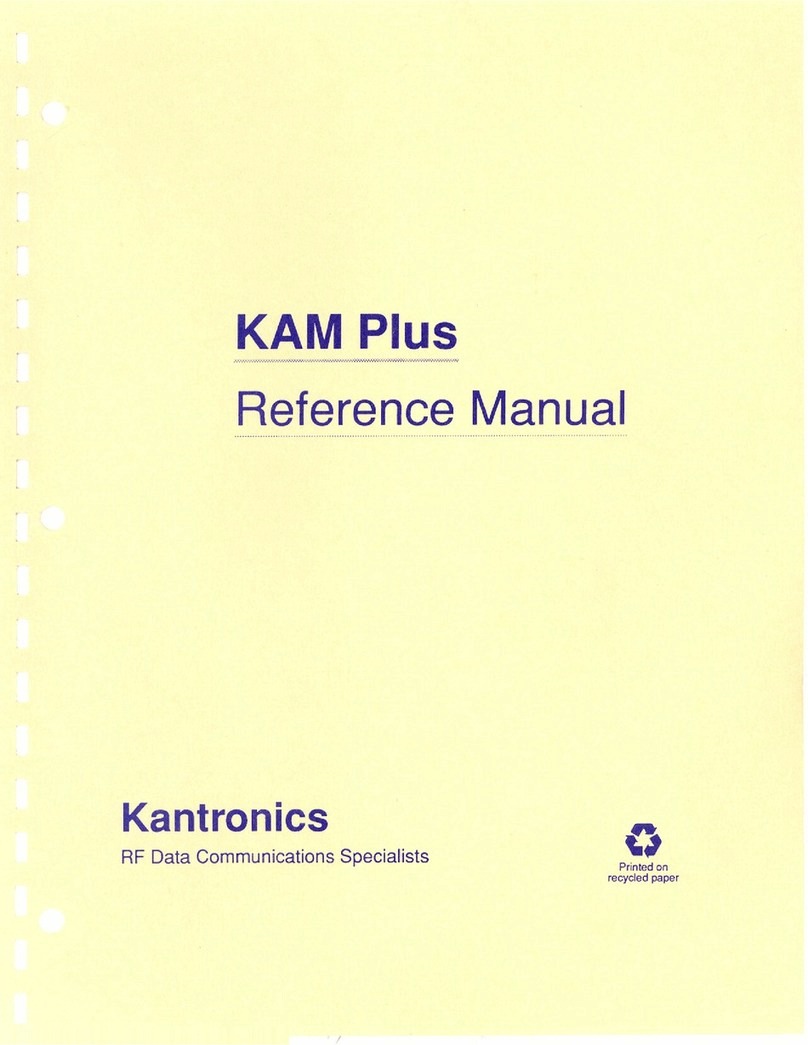Icom IC-M36 User manual

INSTRUCTION MANUAL
|M36
VHF MARINE TRANSCEIVER
This device complies with Part 15 of the FCC Rules. Operation is
subject to the condition that this device does not cause harmful
interference.

Thank you for choosing this Icom product.
This product is designed and built with Icom’ s state of the art
technology and craftsmanship. With proper care, this product
should provide you with years of trouble-free operation.
IMPORTANT
READ ALL INSTRUCTIONS carefully and com-
pletely before using the transceiver.
SAVE THIS INSTRUCTION MANUAL—This
instruction manual contains important operating instructions
for the IC-M36 vhf marine transceiver.
EXPLICIT DEFINITIONS
WORD DEFINITION
RDANGER Personal death, serious injury or an
explosion may occur.
RWARNING Personal injury, fire hazard or electric
shock may occur.
CAUTION Equipment damage may occur.
NOTE
If disregarded, inconvenience only. No risk
of personal injury, fire or electric shock.
FEATURES
☞Floating on water
The transceiver floats on fresh or salt
water, even when the supplied acces-
sories are attached.
• When a third-party battery pack, strap,
antenna, and so on, is used, it may sink.
• The battery contacts may be prone to rust
if the transceiver is kept floating on the
water.
☞Clear voice boost
The transceiver has a noise detection function which en-
ables automatic volume adjustment, and the volume loud
function that enables you to maximize the volume level
instantly to provide clear communication in the noisy ma-
rine environments.
☞Noise cancelling microphone
The sub-microphone on the rear panel inverts the phase
and cancels out the ambient noise from the main micro-
phone. As a result, the transceiver can reduce the influ-
ence of the background noise (particularly treble noise)
on the transmitted signal.
• The noise cancellation can produce no effect according to con-
ditions such as loudness and type of noise, or the position and
distance between the noise source and the microphone, etc.
• The noise cancellation does not work when an optional exter-
nal speaker-microphone is connected.
i

ii
IN CASE OF EMERGENCY RECOMMENDATION
If your vessel requires assistance, contact other vessels and
the Coast Guard by sending a distress call on Channel 16.
❍ USING CHANNEL 16
DISTRESS CALL PROCEDURE
1. “MAYDAY MAYDAY MAYDAY.”
2. “THIS IS ……………… ” (name of vessel)
3.Your call sign or other indication of the ves-
sel.
4. “LOCATED AT …………… ” (your position)
5. The nature of the distress and assistance
required.
6. Any other information which might facilitate
the rescue.
CLEAN THE TRANSCEIVER THOROUGHLY IN A BOWL
OF FRESH WATER after exposure to saltwater, and dry
it before operating. Otherwise, the transceiver’s keys,
switches, and controllers may become unusable, due to salt
crystallization, and/or the charging terminals of the battery
pack may corrode.
NOTE: If the transceiver’s waterproof protection appears
defective, carefully clean it with a soft, damp (fresh water)
cloth, then dry it before operating.
The transceiver may lose its waterproof protection if the
case, jack cap, or connector cover is cracked or broken,
the transceiver has been dropped, or the battery pack is
detached.
Contact your Icom distributor or your dealer for advice.

FCC INFORMATION
This equipment has been tested and found to comply with the
limits for a Class A digital device, pursuant to part 15 of the
FCC Rules. These limits are designed to provide reasonable
protection against harmful interference when the equipment
is operated in a commercial environment. This equipment
generates, uses, and can radiate radio frequency energy
and, if not installed and used in accordance with the instruc-
tion manual, may cause harmful interference to radio com-
munications.
Operation of this equipment in a residential area is likely to
cause harmful interference in which case the user will be re-
quired to correct the interference at his own expense.
PRECAUTIONS
RDANGER! NEVER short terminals of the battery pack.
Also, current may flow into nearby metal objects such as a key,
so be careful when placing the battery packs (or the transceiver)
in handbags, and so on. Simply carrying with or placing near
metal objects such as a key, and so on may cause shorting. This
may damage not only the battery pack, but also the transceiver.
RDANGER! NEVER use and charge other than the speci-
fied Icom battery pack with Icom radios or Icom charger. Only
Icom battery pack is tested and approved for use and charge
with Icom radios or Icom charger. Using third-party or counterfeit
battery packs or charger may cause smoke, fire, or cause the
battery to burst.
RDANGER! NEVER operate the transceiver near un-
shielded electrical blasting caps or in an explosive atmosphere.
RWARNING! NEVER connect the transceiver to an AC
outlet. This may pose a fire hazard or result in an electric shock.
RWARNING! NEVER hold the transceiver so that the an-
tenna is closer than 2.5 cm (1 inch) from exposed parts of the
body, especially the face or eyes, while transmitting. The trans-
ceiver will perform best if the microphone is 5 to 10 cm (2 to 4
inches) away from the lips and the transceiver is vertical.
iii

iv
CAUTION: DO NOT attach the battery unless the flexible
antenna, battery pack and jack cover are securely attached to
the transceiver. Confirm that the antenna and battery pack are
dry before attaching. Exposing the inside of the transceiver to
dust or water can cause serious damage to the transceiver.
After exposure to water, clean the battery contacts thoroughly
with fresh water and dry them completely to remove any water
or salt residue.
NEVER connect the transceiver to a power source other than
the BP-251 (option) or BP-252. Such a connection will ruin the
transceiver.
DO NOT operate or place the transceiver in direct sunlight or
in areas with temperatures below –20°C (–4°F) or above +60°C
(+140°F).
DO NOT use harsh solvents such as Benzine or alcohol when
cleaning, as they will damage the transceiver surfaces.
DO NOT push [PTT] when not actually intending to transmit.
DO NOT modify the transceiver. The transceiver warranty does
not cover any problems caused by unauthorized modifications.
PLACE the transceiver in a secure place to avoid inadvertent
use by unauthorized persons.
KEEP the transceiver at least 0.9 meters (3.0 ft) away from
your vessel’s magnetic navigation compass.
BE CAREFUL! The transceiver’s right-side panel will become
hot when operating continuously for long periods of time.
BE CAREFUL! The transceiver meets IPX7* requirements
for waterproof protection. However, once the transceiver has
been dropped, waterproof protection cannot be guaranteed
because of possible damage to the transceiver's case or the
waterproof seal.
* Only when the BP-251 (option) or BP-252, flexible antenna, [SP
MIC] cap is attached.
MAKE SURE to turn OFF the transceiver power before con-
necting or disconnecting the supplied or optional accessory.
Icom is not responsible for the destruction, damage to, or per-
formance of any Icom or non-Icom equipment, if the malfunc-
tion is because of:
• Force majeure, including, but not limited to, fires, earthquakes,
storms, floods, lightning, other natural disasters, disturbanc-
es, riots, war, or radioactive contamination.
• The use of Icom transceivers with any equipment that is not
manufactured or approved by Icom.
For USA only
CAUTION: Changes or modifications to this device, not
expressly approved by Icom Inc., could void your authority to
operate this device under FCC regulations.
Icom, Icom Inc. and the Icom logo are registered trademarks of Icom Incor-
porated (Japan) in Japan, the United States, the United Kingdom, Germany,
France, Spain, Russia, Australia, New Zealand, and/or other countries.
AquaQuake is a trademark of Icom Incorporated.
PRECAUTIONS (Continued)

v
IMPORTANT...................................................................................... i
EXPLICIT DEFINITIONS................................................................... i
FEATURES........................................................................................ i
IN CASE OF EMERGENCY............................................................. ii
RECOMMENDATION ....................................................................... ii
FCC INFORMATION ....................................................................... iii
PRECAUTIONS............................................................................... iii
1 OPERATING RULES ..................................................................1
2 SUPPLIED ACCESSORIES AND ATTACHMENTS ...............2–3
■Supplied accessories...............................................................2
■Attachments.............................................................................2
3 PANEL DESCRIPTION ........................................................... 4–7
■
Front, top, side and rear panels.....................................................4
■Function display.......................................................................6
4 BASIC OPERATION .............................................................8–13
■Channel selection ....................................................................8
■Receiving and transmitting ....................................................10
■Call channel programming.....................................................11
■Adjusting the volume level .....................................................11
■Volume loud function..............................................................12
■Volume mute function ............................................................12
■Adjusting the squelch level ....................................................12
■Lock function..........................................................................13
■Monitor function .....................................................................13
■Automatic backlighting...........................................................13
■AquaQuake water draining function....................................... 13
5 SCAN OPERATION ............................................................14–15
■Scan types.............................................................................14
■Setting TAG channels ............................................................15
■Starting a scan.......................................................................15
6 DUALWATCH/TRI-WATCH .......................................................16
■Description.............................................................................16
■Operation...............................................................................16
7 SET MODE..........................................................................17–20
■Set mode programming .........................................................17
■Set mode items......................................................................18
8 BATTERY CHARGING .......................................................21–24
■Battery caution.......................................................................21
■Supplied battery charger .......................................................23
■Optional battery case.............................................................23
■Optional battery charger ........................................................24
9 OPTIONAL SPEAKER-MICROPHONE....................................25
■HM-165 descriptions..............................................................25
■Attachment.............................................................................25
10 TROUBLESHOOTING ..............................................................26
11 VHF MARINE CHANNEL LIST.................................................27
12 SPECIFICATIONS AND OPTIONS...........................................28
■Specifications.........................................................................28
■Options ..................................................................................28
13 SAFETY TRAINING INFORMATION ........................................ 29
TABLE OF CONTENTS

D Priorities
• Read all rules and regulations pertaining to priorities and
keep an up-to-date copy handy. Safety and distress calls
take priority over all others.
• You must monitor Channel 16 when you are not operating
on another channel.
• False or fraudulent distress calls are prohibited under law.
D Privacy
• Information overheard but not intended for you cannot law-
fully be used in any way.
• Indecent or profane language is prohibited.
D Radio licenses
(1) SHIP STATION LICENSE
You must have a current radio station license before using
the transceiver. It is unlawful to operate a ship station which
is not licensed.
Inquire through your dealer or the appropriate government
agency for a Ship-Radiotelephone license application. This
government-issued license states the call sign which is your
craft’s identification for radio purposes.
(2) OPERATOR’S LICENSE
A Restricted Radiotelephone Operator Permit is the license
most often held by small vessel radio operators when a radio
is not required for safety purposes.
The Restricted Radiotelephone Operator Permit must be
posted or kept with the operator. Only a licensed radio op-
erator may operate a transceiver.
However, non-licensed individuals may talk over a trans-
ceiver if a licensed operator starts, supervises, ends the call
and makes the necessary log entries.
A current copy of the applicable government rules and regu-
lations is only required to be on hand for vessels in which a
radio telephone is compulsory. However, even if you are not
required to have these on hand it is your responsibility to be
thoroughly acquainted with all pertinent rules and regula-
tions.
NOTE: Even though the IC-M36 is capable of operation
on VHF marine channels 3, 21, 23, 61, 64, 81, 82 and
83, according to FCC regulations these simplex channels
cannot be lawfully used by the general population in USA
waters.
1
1
OPERATING RULES
1
2
3
4
5
6
7
8
9
10
11
12
13
14
15
16

2
SUPPLIED ACCESSORIES AND ATTACHMENTS
2
■Supplied accessories
Battery packHandstrap
Belt clip
Battery charger*
(with 2 screws)
Antenna
Power adapter*
* Different type is supplied or not supplied, depending on the
transceiver version.
■Attachments
DFlexible antenna
Connect the supplied flexible an-
tenna to the antenna connector.
CAUTION:
• NEVER carry the transceiver
by holding only the antenna.
• Transmitting without an an-
tenna may damage the trans-
ceiver.
DHandstrap
Pass the handstrap through
the loop on the back side of
the transceiver. This facili-
tates carrying.
DBelt clip
Attach/detach the belt clip to the transceiver.
To attach the belt clip To detach the belt clip
Be careful!
Do not
break your
fingernails.
q
w

Screw position
when removing battery
Screw position
when attaching battery
Make sure the rubber seal (purple) is properly seated in the
groove and dust or other material does not adhere to it.
Battery pack Battery pack
Rubber seal
Groove
Correct position Incorrect position
NOTE:
When attaching a battery pack, make sure dust or other
material does not adhere to the rubber seal. If dust or other
material is on the seal when attaching a battery pack,
waterproof protection may not be guaranteed.
ïBattery pack
To remove the battery pack:
Turn the screw counter clockwise one quarter turn, then pull
the battery pack in the direction of the arrow, as shown below.
To attach the battery pack:
Insert the battery pack in the transceiver completely, then
turn the screw clockwise one quarter turn.
NEVER remove or insert the battery pack when the trans-
ceiver is wet or soiled. This may result water or dust get-
ting into the transceiver/battery pack and may result in the
transceiver being damaged.
NOTE: When removing or attaching the battery pack, use
a coin or standard screwdriver to loosen or tighten the
bottom screw.
CAUTION:
When attaching or removing a battery pack, make sure
the rubber seal is correctly set in the groove of the battery
pack. If the seal is not correctly in the groove, it may be
damaged when attaching the battery pack. If the seal is
damaged, waterproof protection is not guaranteed.
3
2
SUPPLIED ACCESSORIES AND ATTACHMENTS
1
2
3
4
5
6
7
8
9
10
11
12
13
14
15
16

4
PANEL DESCRIPTION
3
■
Front, top, side and rear panels
qANTENNA CONNECTOR (p. 2)
Connects to the supplied antenna.
w
SPEAKER-MICROPHONE CONNECTOR [SP MIC] (p. 25)
Connects to the optional external speaker-microphone.
NOTE: Attach the [SP MIC] cap when the optional
speaker-microphone is not used. Otherwise, water will
get into the transceiver.
qAttach the
[SP MIC]
cap.
wThen rotate it
completely
clockwise.
q
w
e PTT SWITCH [PTT]
Hold down to transmit, release to receive. (p. 10)
rCHANNEL 16 KEY [16 9]
➥Push to select Channel 16. (p. 8)
➥Hold down for 1 second
to
select the Call channel. (p. 8)
➥When the Call channel is selected, hold down for 3
seconds to enter the Call channel entry mode.(p.11)
➥While in the set mode, push to return to the normal
mode.(p.17)
Function
display
(pp. 6, 7)
Speaker
y
t
r
e
u
w
q
!1
o
i
!0
Microphone
!2
Sub-microphone
(p. i)

t VOLUME/SQUELCH/MONITOR KEY [VOL/SQL MONI]
➥Push to enter the volume adjustment mode and the
squelch adjustment mode. (pp. 11, 12)
➥Push to restore the changed volume level by the noise
detection, volume loud, or volume mute function to the
original. (pp. 12, 20)
➥Hold down for 1 second to activate the monitor func-
tion. (p. 13)
➥While holing down this key, turn ON the power to enter
the set mode. (p. 17)
➥While in the set mode, push to select an item. (p. 17)
ySCAN/DUAL KEY [SCAN DUAL]
➥Push to start or stop normal or priority scan. (p. 15)
➥Hold down for 1 second
to enter the watch mode. (p. 16)
➥Push to exit the watch mode. (p. 16)
➥Hold down this key and
[Hi/Lo ]
, to activate the
Aq
uaQuake function. (p. 13)
uCHANNEL UP/DOWN KEYS [Y]/[Z]
➥Selects an operating channel. (pp. 8, 9)
➥While in the set mode, selects the setting or value of an
item. (p. 17)
➥Checks TAG channels or changes scanning direction
during scan. (p. 15)
iFAVORITE/TAG KEY [FAV TAG]
➥Push this key to select the favorite (TAG) channels
with ignoring untagged channels in a channel group in
sequence. (p. 8)
➥Hold down for 1 second to set or clear TAG for the dis-
played channel. (p. 15)
➥While holding down this key, turn ON the power to
clear or set all TAG channels in the selected channel
group. (p. 15)
oCHANNEL/WEATHER CHANNEL KEY [CH/WX U/I/C]
➥Push to switch between the regular channel and
weather channel. (p. 9)
➥Hold down for 1 second to select the channel group
from USA, International and Canada. (p. 9)
➥Push to return to the previous channel before selecting
Channel 16 or the Call channel.
!0 TRANSMIT POWER/LOCK KEY [Hi/Lo ]
➥
Push to
select the output power
from high
and
low.
(p. 10)
➥Hold down for 1 second to turn the key lock function
ON or OFF. (p. 13)
!1 POWER KEY [ ]
➥Hold down for 1 second to turn the power ON or OFF.
!2 LOUD/MUTE KEY [LOUD MUTE]
➥
Push to turn the volume loud function ON or OFF. (p. 12)
➥Hold down for 1 second to turn ON the volume mute
function, and push to turn OFF the function. (p. 12)
5
3
PANEL DESCRIPTION
1
2
3
4
5
6
7
8
9
10
11
12
13
14
15
16
Volume adjustment mode
Normal condition
Squelch adjustment mode
PUSH
PUSH
PUSH

6
3PANEL DESCRIPTION
■Function display
q TRANSMIT INDICATOR (p. 10)
Appears while transmitting.
w BUSY INDICATOR
➥Appears when receiving a signal or when the squelch
opens. (p. 10)
➥Blinks while monitoring. (p. 13)
e TAG CHANNEL INDICATOR (p. 15)
Appears when a TAG channel is selected.
r CALL CHANNEL INDICATOR (p. 8)
Appears when the Call channel is selected.
t LOCK INDICATOR (p. 13)
Appears while the lock function is activated.
y BATTERY INDICATOR
Indicates remaining battery power.
Indication
Full Middle Charging
required No battery
Battery level
blinks when the battery is exhausted.
blinks when the battery is over charged.
u SCAN INDICATOR (p. 15)
Blinks during scan.
i DUALWATCH/TRI-WATCH INDICATORS (p. 16)
“DUAL” appears during Dualwatch,“TRI” appears during
Tri-watch.
o DUPLEX INDICATOR
Appears when a duplex channel is selected.
!0 SUB CHANNEL READOUT
➥Indicates Channel 16 during priority scan, Dualwatch or
Tri-watch. (p. 16)
➥Indicates the set mode item while in the set mode. (p. 17)
➥Indicates the volume level while in the volume adjust-
ment mode. (p. 11)
➥Indicates the squelch level while in the squelch adjust-
ment mode. (p. 12)
!5 !3!4
i
u
o
!2
!1
!0
!8
!6
qerytw
!7

!1 SQUELCH LEVEL INDICATOR
Shows the squelch level.
!2 VOLUME LEVEL INDICATOR
➥Shows the volume level.
➥The bars repeatedly appear in ascending order when
the volume loud function is activated. (p. 12)
➥Blinks while the volume mute is activated. (p. 12)
!3 VOLUME LEVEL ADJUSTING INDICATOR (p. 11)
➥Blinks while adjusting the volume level.
➥This indicator and the volume level indicator alternately
appear while the volume level is turned up by the noise
detection function. (p. 20)
!4 SQUELCH LEVEL ADJUSTING INDICATOR (p. 12)
Blinks while adjusting the squelch level.
!5 CHANNEL NUMBER READOUT
➥Indicates the selected operating channel number.
➥
In the set mode, indicates the selected option or value.
(p. 17)
!6 CHANNEL GROUP INDICATOR (p. 9)
“ ” appears when USA, “ ” appears when Interna-
tional, “ ” appears when Canadian channel group is se-
lected each.
!7 WEATHER CHANNEL/WEATHER ALERT INDICATORS
(p. 9)
➥“WX” appears when the weather channel group is se-
lected.
➥“WX ALT” appears while the weather alert function is
activated, blinks when the alert tone is received.
!8 LOW POWER INDICATOR (p. 10)
➥“LOW” appears when low power is selected.
➥“LOW” blinks when switching to the forced low power
mode because of a high temperature error or low volt-
age.
7
3
PANEL DESCRIPTION
1
2
3
4
5
6
7
8
9
10
11
12
13
14
15
16

8
BASIC OPERATION
4
■Channel selection
IMPORTANT: Prior to using the transceiver for the first
time, the battery pack must be fully charged for optimum
life and operation. To avoid damage to the transceiver,
turn OFF the power while charging.
DChannel 16
Channel 16 is the distress and safety channel. It used for
establishing initial contact with a station and for emergency
communications. Channel 16 is monitored during both Du-
alwatch and Tri-watch. While in the standby mode, you must
monitor Channel 16.
qPush [16 9] momentarily to select Channel 16.
wPush [CH/WX U/I/C] to return to the channel used before
Channel 16, or push [Y]/[Z]to select a channel.
Convenient!
While holding down [FAV TAG], push [Y]/[Z] to select the
favorite (TAG) channels with ignoring untagged channels in
the selected channel group in sequence.
• Pushing [FAV TAG] only advances the displayed TAG channel.
• The favorite channels are selected using the TAG channel setting.
(p. 15)
DChannel 9 (Call channel)
Each regular channel group has separate leisure-use Call
channels. The Call channel is monitored during Tri-watch.
The Call channels can be programmed (p. 11) and are used
to store your most often used channel in each channel group
for quick recall.
qHold down [16 9] for 1 second to select the Call channel
of the selected channel group.
• “CALL” and Call channel number appear.
• Each channel group can have an independent Call channel
after entering a Call channel. (p. 11)
wPush [CH/WX U/I/C] to return to the channel used before
the Call channel, or push [Y]/[Z]to select a channel.
Push
Hold do
wn for
1 second

DUSA, International and Canadian channels
The transceiver is preset with 59 USA, 59 International and
63 Canadian channels. These channel groups may be speci-
fied for the operating area.
qPush [CH/WX U/I/C] to select a regular channel.
• If a weather channel appears, push [CH/WX U/I/C] again.
wHold down [CH/WX U/I/C] for 1 second to change the
channel group. Repeat to advance to the next group.
• USA, International and Canadian channel groups can be se-
lected in sequence.
ePush [Y]/[Z]to select a channel.
• “DUP” appears for duplex channels.
Hold down
U.S.A. channels
International channels Canadian channels
for 1 second
DWeather channels
The transceiver has 10 preset weather channels. These are
used for monitoring broadcasts from the NOAA (National
Oceanic and Atmospheric Administration).
The transceiver can automatically detect a weather alert
tone on the selected weather channel while receiving an-
other channel or during scan. (p. 18)
qPush [CH/WX U/I/C] once or twice to select a weather
channel.
• “WX” appears when a weather channel is selected.
• “WX ALT” appears when the weather alert function is turned
ON. (p. 18)
wPush [Y]/[Z]to select a weather channel.
9
4
BASIC OPERATION
1
2
3
4
5
6
7
8
9
10
11
12
13
14
15
16
Push once or twice.
W
eather alert is OFF.Weather alert is ON.

10
4BASIC OPERATION
■Receiving and transmitting
CAUTION: Transmitting without an antenna may damage
the transceiver.
q Hold down []to turn ON the power.
w Set the volume and squelch levels.
You can enter each adjust mode with [VOL/SQL MONI].
➥ Enter the squelch adjustment mode, and push [Z]sev-
eral times to open the squelch.
➥Enter the volume adjustment mode, then push [Y]/[Z]
to adjust the volume level.
➥Enter the squelch adjustment mode again, and push
[Y]until the noise disappears.
e Push [Y]/[Z]to select the channel.
• When receiving a signal, “ ” appears and audio is emitted
from the speaker.
• Further adjustment of the audio may be necessary at this point.
r Push [Hi/Lo ] to select the output power if necessary.
• “LOW” appears when low power is selected, no indication when
high power is selected.
• Choose low power for short range communications, choose
high power for longer distance communications.
• Some channels are for low power only.
t Hold down [PTT] to transmit, then speak into the
microphone.
• “ ” appears.
• Channel 70 cannot be used for transmission.
y Release [PTT] to receive.
IMPORTANT: To maximize the readability of your trans-
mitted signal, pause a few seconds after pushing [PTT],
hold the microphone 5 to 10 cm (2 to 4 inches) from your
mouth and speak into the microphone at your normal
voice level.
NOTE: The transceiver has a power save function to con-
serve the battery power. The power save function auto-
matically activates when no signal is received for 5 sec-
onds.
For U.S.A version: To prevent accidental prolonged
transmission, the transceiver has a time-out timer func-
tion. This timer cuts off a transmission after 5 minutes. of
continuous transmission.
Microphone
rSet output
power.
qPower ON.
tPush to
transmit.
yRelease to
receive.
eSet channel.
Enter the volume
and squelch ad-
justment mode.
w
wAdjust the
volume and
squelch
level.

■Call channel programming
The Call channel is used to access Channel 9 (default).
However, you can enter the Call channel with your most
often-used channels in each channel group for quick recall.
qHold down [CH/WX U/I/C] for 1 second several times to
select the channel group (USA, International or Canada)
to be programmed. (p. 9)
wHold down [16 9] for 1 second to select the Call channel
of the selected channel group.
• “CALL” and Call channel number appear.
eHold down [16 9] again for 3 sec-
onds. (until a long beep changes
to 2 short beeps) to enter the Call
channel entering mode.
• Channel number starts blinking.
rPush [Y]/[Z]to select the chan-
nel.
tPush [16 9] to program the dis-
played channel as the Call chan-
nel.
• The channel number stops blinking.
■Adjusting the volume level
The volume level can be adjusted with [VOL/SQL MONI]
and [Y]/[Z].
qPush [VOL/SQL MONI] once to enter the volume adjust-
ment mode, then adjust the volume level with [Y]/[Z].
• “VOL” indicator starts blinking.
• The transceiver has 31 volume levels and OFF.
• With no key operation is performed for 5 seconds, the trans-
ceiver returns to the normal condition.
wPush [VOL/SQL MONI] twice to exit the volume adjust-
ment mode.
11
4
BASIC OPERATION
1
2
3
4
5
6
7
8
9
10
11
12
13
14
15
16
Indicates the
volume level.
Blinks while adjusting the volume level.

12
4BASIC OPERATION
■Volume loud function
The volume loud function can be temporarily activated by
pushing [LOUD MUTE].
The function does not work when the volume level is 31.
qPush [LOUD MUTE] to activate the volume loud function.
• The volume level is set to the maximum level (level 31).
• The bars of the volume level indicator repeatedly appears in
ascending order.
wPush [LOUD MUTE] again, or push [VOL/SQL MONI] to
turn OFF the volume loud function.
■Volume mute function
The volume mute function can be temporarily activated by
holding down [LOUD MUTE].
The function does not work when the volume level is OFF.
qHold down [LOUD MUTE] for 1 second to activate the
volume mute function.
• The volume level is set to the minimum level (OFF).
• The volume level indicator blinks.
wPush [LOUD MUTE] again, or push [VOL/SQL MONI] to
turn OFF the volume mute function.
■Adjusting the squelch level
The squelch level can be adjusted with [VOL/SQL MONI]
and [Y]/[Z].
To properly receive signals, as well as for the scan to func-
tion effectively, the squelch must be adjusted to the proper
level.
qPush [VOL/SQL MONI] twice to enter the squelch adjust-
ment mode, then adjust the squelch level with [Y]/[Z].
• “SQL” indicator starts blinking.
• The transceiver has 11 squelch levels. OP is completely
open,10 is tight squelch, 1 is loose squelch.
• With no key operation is performed for 5 seconds, the trans-
ceiver returns to the normal mode.
wPush [VOL/SQL MONI] again to exit the squelch adjust-
ment mode.
Indicates the
squelch level.
Blinks while adjusting the squelch level.

■Lock function
This function electronically locks all keys (except for [PTT],
[VOL/SQL MONI], [LOUD MUTE], [Hi/Lo ]and [Y]/[Z]*)
to prevent accidental channel changes and function access.
* In the volume or squelch adjustment mode only.
➥Hold down
[Hi/Lo ]
for 1 second to turn the lock func-
tion ON or OFF.
■Monitor function
The monitor function opens the squelch. The monitor key ac-
tion can be selected in the set mode. (p. 19)
➥The monitor function is activated by holding down
[VOL/
SQL MONI] for 1 second
.
• “ ” blinks and the squelch is opened.
■Automatic backlighting
This function lights the function display and keys, and it is
convenient for night-time operation. The automatic backlight-
ing can be activated in the set mode. (p. 19)
➥
Push any key except for [PTT] to turn ON the backlight.
•
The backlight is automatically turned OFF after 5 seconds of in-
activity.
■AquaQuake water draining
function
The AquaQuake water draining function clears water away
from the speaker grill. Without this function, water may muffle
the sound coming from the speaker. The transceiver emits a
vibrating sound when this function is activated.
➥Hold down both [SCAN DUAL] and [Hi/Lo ].
• A low tone sounds for 9 seconds to drain water, regardless of
the volume level setting.
• You cannot do any key operation while the AquaQuake function
is activated.
• The AquaQuake function can not be activated when an optional
speaker-microphone is connected.
13
4
BASIC OPERATION
1
2
3
4
5
6
7
8
9
10
11
12
13
14
15
16
Blinks while the monitor function is activated.
Hod do
wn
f
or 1 second
Appears while the lock function is activated.
Hold do
wn
f
or 1 second

14
SCAN OPERATION
5
■Scan types
Scanning is an efficient way to locate signals quickly over a
wide frequency range. The transceiver has priority scan and
normal scan.
In addition, the weather alert and auto scan functions are
available for standby convenience. These functions can be
simultaneously activated, depending on the setting in the set
mode. (pp. 18, 19)
Set the TAG channels (scanned channels) before scanning.
Clear the TAG for unwanted channels which inconveniently
stop scanning, such as those for digital communications.
(p. 15)
Choose the scan type from "Priority" or "Normal" in the
set mode. (p. 18)
PRIORITY SCAN
WX*
CH 01
CH 16
CH 02
CH 05 CH 04
CH 03
Previously selected weather channel.
(when the weather alert function is activated)
*
Priority scan searches through all TAG channels in se-
quence while monitoring Channel 16. When a signal is
detected on Channel 16, scan pauses until the signal
disappears. When a signal is detected on a channel other
than Channel 16, scan becomes Dualwatch until the sig-
nal disappears.
NORMAL SCAN
CH 01 CH 02
WX*
CH 05 CH 04
CH 03
Previously selected weather channel.
(when the weather alert function is activated)
*
Normal scan, like priority scan, searches through all TAG
channels in sequence. However, unlike priority scan,
Channel 16 is not checked unless Channel 16 is set as a
TAG channel.
Other manuals for IC-M36
2
Table of contents
Other Icom Transceiver manuals
Popular Transceiver manuals by other brands
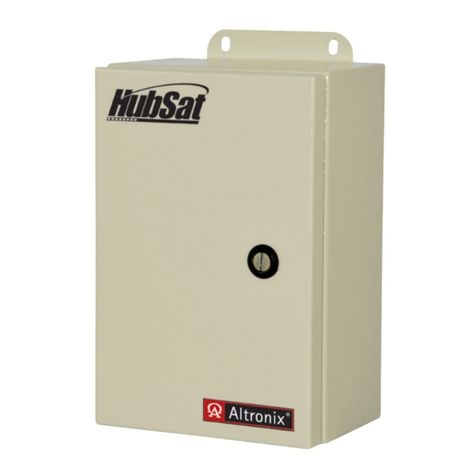
Altronix
Altronix HubSat4WPiV installation guide
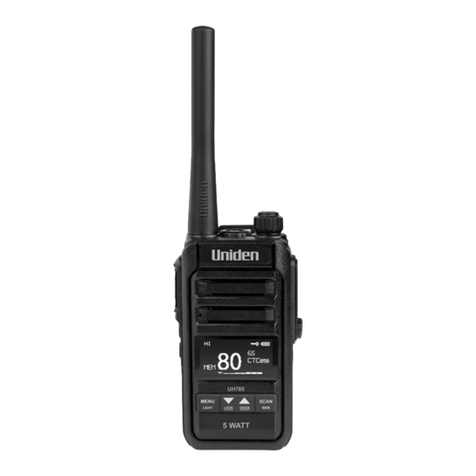
Uniden
Uniden UH785 Series owner's manual
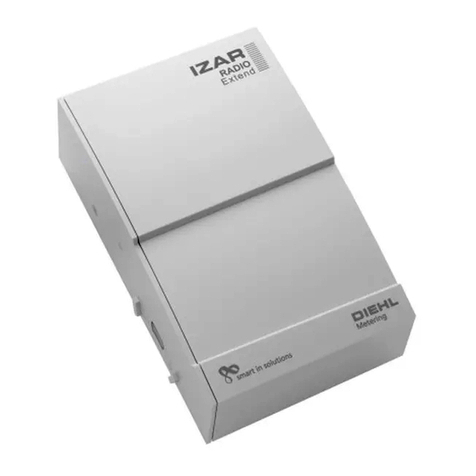
Diehl Metering
Diehl Metering IZAR RADIO Extend installation guide
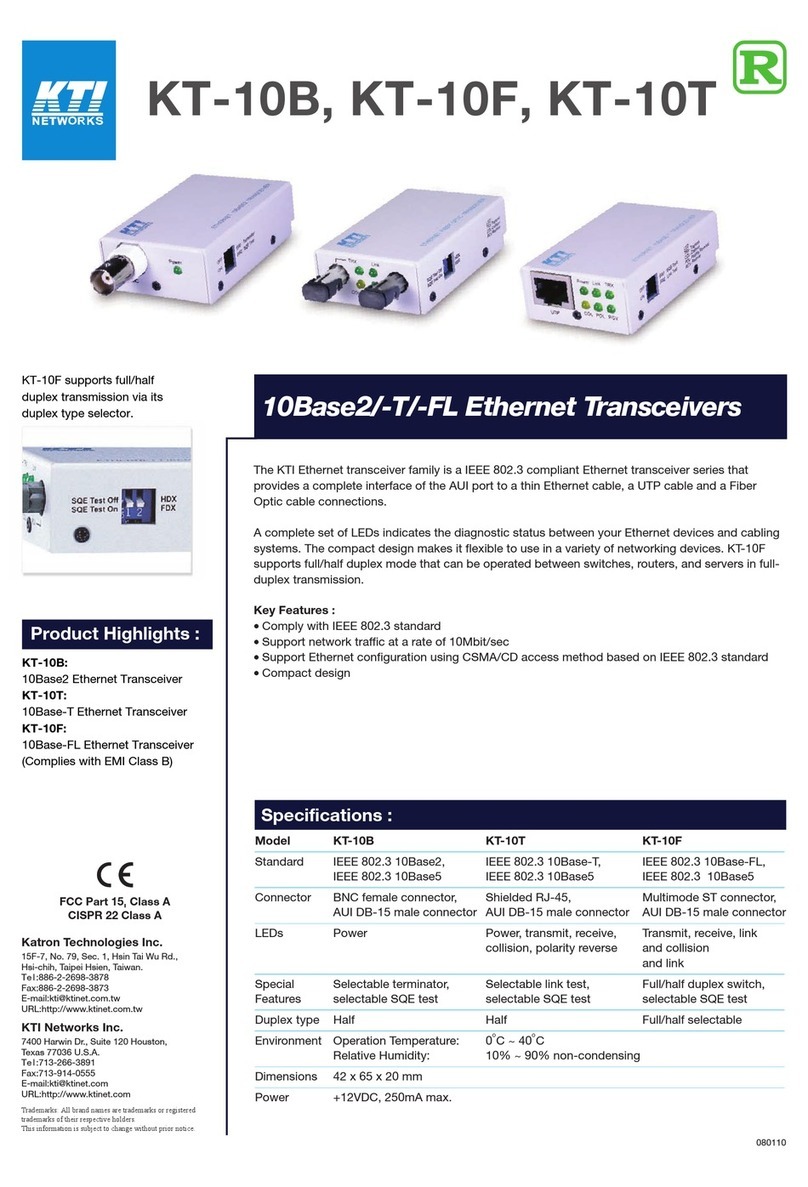
KTI Networks
KTI Networks KT-10B Specification sheet
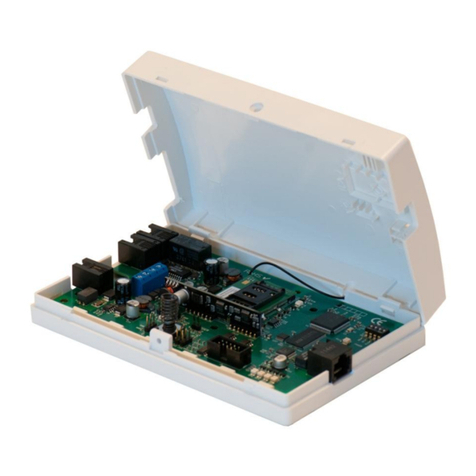
alphatronics
alphatronics PSTN-2-IP GPRS Quick reference guide
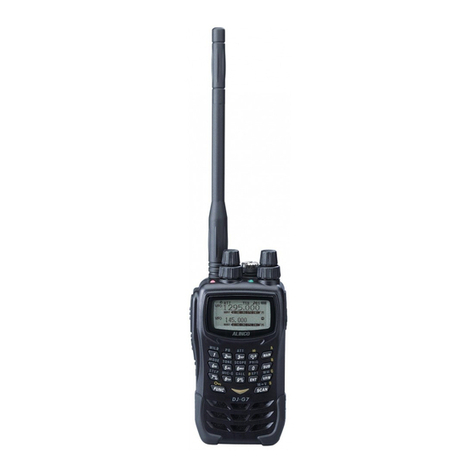
Alinco
Alinco DJ-G7 instruction manual

